“with + 复合宾语”结构归纳
with的复合结构和独立主格结构
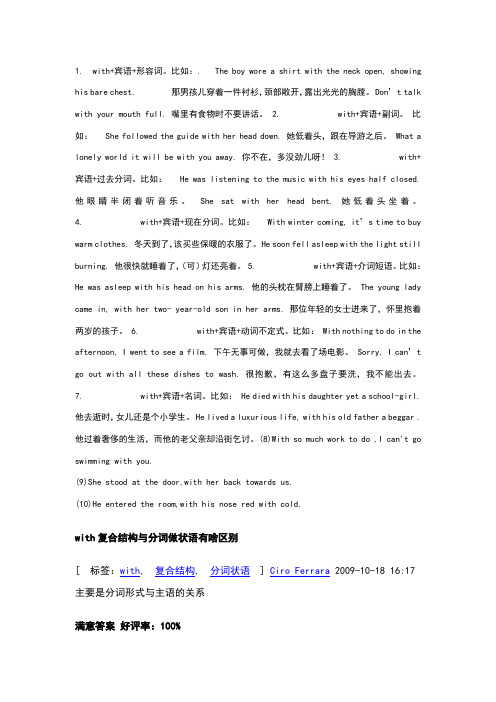
1. with+宾语+形容词。
比如:. The boy wore a shirt with the neck open, showing his bare chest. 那男孩儿穿着一件衬衫,颈部敞开,露出光光的胸膛。
Don’t talk with your mouth full. 嘴里有食物时不要讲话。
2. with+宾语+副词。
比如:She followed the guide with her head down. 她低着头,跟在导游之后。
What a lonely world it will be with you away. 你不在,多没劲儿呀!3. with+宾语+过去分词。
比如:He was listening to the music with his eyes half closed. 他眼睛半闭着听音乐。
She sat with her head bent. 她低着头坐着。
4. with+宾语+现在分词。
比如:With winter coming, it’s time to buy warm clothes. 冬天到了,该买些保暖的衣服了。
He soon fell asleep with the light still burning. 他很快就睡着了,(可)灯还亮着。
5. with+宾语+介词短语。
比如:He was asleep with his head on his arms. 他的头枕在臂膀上睡着了。
The young lady came in, with her two- year-old son in her arms. 那位年轻的女士进来了,怀里抱着两岁的孩子。
6. with+宾语+动词不定式。
比如: With nothing to do in the afternoon, I went to see a film. 下午无事可做,我就去看了场电影。
Sorry, I can’t go out with all these dishes to wash. 很抱歉,有这么多盘子要洗,我不能出去。
With的复合结构超全

anyone helping them. = They finished the work with no
one helping them.
1)With nothing _______ to burn,the fire became weak and finally died
With so much work to do, we can’t go out to play.
7. 由那个老人带路,我们终于找到了那个 地方。
With the old man leading the way, we found the place at last.
3.with + 宾语 + 介词短语
The teacher came in with a book in his hand.
老师手里拿着书走进来。
The girl looked up with tears in her eyes.
那女孩眼泪汪汪地抬起头。
4.with + 宾语 + 名词
They set up a football team, with Tom their head.
out.
A. leaving
B. left
C. leave
D. to leave
2)The girl sat there quite silent and still with her eyes _______ on the
wall.
A. fixing
B. fixed
C. to be fixing
最新with复合结构详解汇编
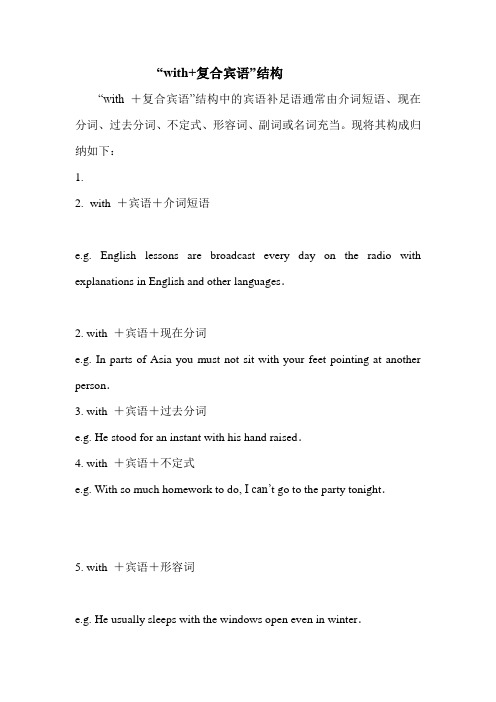
“with+复合宾语”结构
“with +复合宾语”结构中的宾语补足语通常由介词短语、现在分词、过去分词、不定式、形容词、副词或名词充当。
现将其构成归纳如下:
1.
2.with +宾语+介词短语
e.g. English lessons are broadcast every day on the radio with explanations in English and other languages.
2. with +宾语+现在分词
e.g. In parts of Asia you must not sit with your feet pointing at another person.
3. with +宾语+过去分词
e.g. He stood for an instant with his hand raised.
4. with +宾语+不定式
e.g. With so much homework to do, I can’t go to the party tonight.
5. with +宾语+形容词
e.g. He usually sleeps with the windows open even in winter.
6. with +宾语+副词e.g. One family lived in a house with very tall trees all round.
7. with +宾语+名词
e.g. In the centre of London there is a tall white building with the name “Bush House”.。
语法with+复合宾语”结构

With + 复合宾语结构请看NMET2000高考题:_____ the production up by 60%,the company has had another excellent year.A.As B.For C.With D.Through这道题的正确答案是C。
句中的“With+宾语+宾语补足语”结构作状语,表原因。
全句的意思是:由于生产增长了60%,这家公司又迎来了一个丰收年。
“with +复合宾语”结构中的宾语补足语通常由介词短语、现在分词、过去分词、不定式、形容词、副词或名词充当。
它在中学英语课本中多次出现,现将其构成与句法作用归纳如下:“with +复合宾语”结构的一般构成:with +宾语+介词短语English lessons are broadcast every day on the radio with explanations inEnglish and other languages.with +宾语+现在分词In parts of Asia you must not sit with your feet pointing at another person.with +宾语+过去分词He stood for an instant with his hand raised.他举着手站了一会儿。
with +宾语+不定式With so much homework to do,I can't go to the party tonight.由于有这么多家庭作业要做,今天晚上我不能去参加晚会。
with +宾语+形容词He usually sleeps with the windows open even in winter.即使在冬天,他也常常开着窗户睡觉。
with +宾语+副词One family lived in a house with very tall trees all round.with +宾语+名词In the centre of London there is a tall white building with the name“Bush House”.“with +复合宾语”结构的句法作用:作时间状语With my homework finished(=After I finished my homework),I went fishing with my father.做完家庭作业后,我和爸爸去钓鱼了。
with复合宾语的用法

with复合宾语的⽤法with+复合宾语的⽤法⼀、with的复合结构的构成⼆、所谓“with的复合结构”即是“with+复合宾语”也即“with +宾语+宾语补⾜语”的结构。
其中的宾语⼀般由名词充当(有时也可由代词充当);⽽宾语补⾜语则是根据具体的需要由形容词,副词、介词短语,分词短语(包括现在分词和过去分词)及不定式短语充当。
下⾯结合例句就这⼀结构加以具体的说明。
三、1、with +宾语+形容词作宾补四、①He slept well with all the windows open.(82年⾼考题)上⾯句⼦中形容词open作with 的宾词all the windows的补⾜语,②It’s impolite to talk with your mouth full of food.形容词短语full of food作宾补。
Don't sleep with the window open in winter2、with+宾语+副词作宾补with John away, we have got more room.He was lying in bed with all his clothes on.③Her baby is used to sleeping with the light on.句中的on是副词,作宾语the light的补⾜语。
④The boy can t play with his father in.句中的副词in作宾补。
3、with+宾语+介词短语。
we sat on the grass with our backs to the wall.his wife came down the stairs,with her baby in her arms.They stood with their arms round each other.With tears of joy in her eyes ,she saw her daughter married.⑤She saw a brook with red flowers and green grass on both sides.句中介词短语on both sides 作宾语red flowersandgreen grass的宾补,⑥There were rows of white houses with trees in front of them.,介词短语in front of them作宾补。
With复合结构的用法小结[1]
![With复合结构的用法小结[1]](https://img.taocdn.com/s3/m/b213abfc28ea81c758f578c5.png)
With复合结构的用法小结with结构是许多英语复合结构中最常用的一种。
学好它对学好复合宾语结构、不定式复合结构、动名词复合结构和独立主格结构均能起很重要的作用。
本文就此的构成、特点及用法等作一较全面阐述,以帮助同学们掌握这一重要的语法知识。
一、with结构的构成1.with+宾语(名词或代词)+n.Hecutthepaperwitharulerhisknife.他用尺当刀子裁开了纸。
Themanfoughtagainstthethief__________________________.那男子以木棍作武器同盗贼搏斗。
2.with+宾语(名词或代词)+adj.Heusedtosleepwiththewindowopen.(表示伴随情况)他过去经常开着窗户睡觉。
Thechildrenweremakingasnowman,__________________________________.孩子们正在做雪人,双手冻得通红。
(结果状语)3.with+宾语(名词或代词)+adv.Thelittleboyranalongthestreetwithnothingon.小男孩沿街跑着,什么也没穿。
(方式状语)Hefellasleep_______________________________.他睡着了,灯还亮着。
(伴随状语)4.with+宾语(名词或代词)+prep.Thefarmerwenttothefieldwithaspadeonhisshoulder.这位农民肩扛铁锨下田干活了。
Jackwalkedintotheclassroom__________________________________杰克手里拿着几本书,走进了教室。
(表示伴随)(hand)5.with+宾语(名词或代词)+V-ingShefeltnervouswiththewholeclassstaringather.由于全班都盯着她看,她感到紧张。
高中with的复合结构用法

高中with的复合结构用法介词with在英语中非常常见,它可以表示具有、和、用、以、跟、同、带有、使用等多种含义。
除了作为介词后面跟名词或代词作宾语外,with还可以构成复合结构,即with+宾语+宾语补足语。
这种复合结构在句中可以作状语或定语,表示伴随、原因、条件、方式等意义。
宾语补足语可以是形容词、副词、名词、介词短语、现在分词、过去分词或不定式等。
下面我们来具体看看with的复合结构的用法和例句。
1.with+宾语+形容词这种结构表示宾语的特征或状态,常用来作状语或定语。
例句:•He likes to sleep with the window open. 他喜欢开着窗户睡觉。
•She entered the room with her face red with cold. 她脸上冻得通红地走进房间。
•The boy was sitting on the ground with his eyes closed. 男孩闭着眼睛坐在地上。
•With water plentiful, the lawns were green all summer. 因为水很充足,整个夏天草坪都很绿。
•The girl was wearing a dress with flowers printed on it. 女孩穿着一件印有花朵图案的裙子。
2.with+宾语+副词这种结构表示宾语所处的位置或状态,常用来作状语。
例句:•With John away, we’ve got more rooms. 随着约翰离开,我们有了更多房间。
•He stood there with his back to me. 他背对着我站在那里。
•She walked out of the room with a smile on her face. 她面带微笑地走出房间。
•He left the house with nothing said. 他什么也没说就离开了房子。
with复合结构用法归纳

with复合结构用法归纳With 复合结构指的是“with+宾语+宾语补足语”结构,它是一个十分有用的结构,不仅教材中经常出现,考试中经常考到,而且它也是同学们写作时使句子变得“高级”的一个重要手段。
学会正确运用它,你会多方面受益。
with复合结构形式一:with+宾语+形容词He often sleeps with the windows open. 他常开着窗睡觉。
Don’t speak with your mouth full. 不要满嘴巴食物说话。
with复合结构形式二:with+宾语+副词He stood before his teacher with his head down. 他低着头站在老师面前。
He was lying on the bed with all his clothes on. 他和衣躺在床上。
with复合结构形式三:with+宾语+名词He died with his daughter yet a schoolgirl. 他去世时,女儿还是个小学生。
with复合结构形式四:with+宾语+介词短语She said good-bye with tears in her eyes. 她含着眼泪说了声再见。
He was asleep with his head on his arms. 他头枕着胳膊睡着了。
with复合结构形式五:with+宾语+现在分词(短语)He fell asleep with the lamp burning. 他没熄灯就睡着了。
I won’t be able to go on holiday with my mother being ill. 因为妈妈有病,我无法去度假。
with复合结构形式六:with+宾语+过去分词(短语)He sat there with his eyes closed. 他闭目坐在那儿。
All the afternoon he worked with the door locked. 整个下午他都锁着门在房里工作。
with复合结构及词义分析
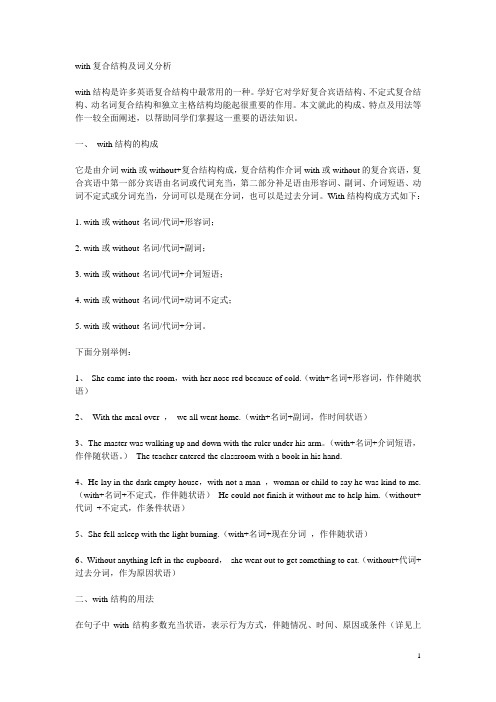
with复合结构及词义分析with结构是许多英语复合结构中最常用的一种。
学好它对学好复合宾语结构、不定式复合结构、动名词复合结构和独立主格结构均能起很重要的作用。
本文就此的构成、特点及用法等作一较全面阐述,以帮助同学们掌握这一重要的语法知识。
一、with结构的构成它是由介词with或without+复合结构构成,复合结构作介词with或without的复合宾语,复合宾语中第一部分宾语由名词或代词充当,第二部分补足语由形容词、副词、介词短语、动词不定式或分词充当,分词可以是现在分词,也可以是过去分词。
With结构构成方式如下:1. with或without-名词/代词+形容词;2. with或without-名词/代词+副词;3. with或without-名词/代词+介词短语;4. with或without-名词/代词+动词不定式;5. with或without-名词/代词+分词。
下面分别举例:1、She came into the room,with her nose red because of cold.(with+名词+形容词,作伴随状语)2、With the meal over ,we all went home.(with+名词+副词,作时间状语)3、The master was walking up and down with the ruler under his arm。
(with+名词+介词短语,作伴随状语。
)The teacher entered the classroom with a book in his hand.4、He lay in the dark empty house,with not a man ,woman or child to say he was kind to me.(with+名词+不定式,作伴随状语)He could not finish it without me to help him.(without+代词+不定式,作条件状语)5、She fell asleep with the light burning.(with+名词+现在分词,作伴随状语)6、Without anything left in the cupboard,she went out to get something to eat.(without+代词+过去分词,作为原因状语)二、with结构的用法在句子中with结构多数充当状语,表示行为方式,伴随情况、时间、原因或条件(详见上述例句)。
with_的复合结构和独立主格结构
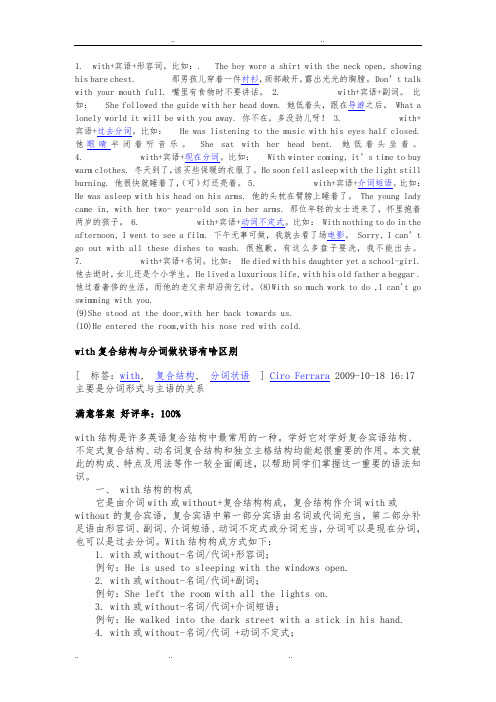
1. with+宾语+形容词。
比如:. The boy wore a shirt with the neck open, showing his bare chest. 那男孩儿穿着一件衬衫,颈部敞开,露出光光的胸膛。
Don’t talk with your mouth full. 嘴里有食物时不要讲话。
2. with+宾语+副词。
比如:She followed the guide with her head down. 她低着头,跟在导游之后。
What a lonely world it will be with you away. 你不在,多没劲儿呀!3. with+宾语+过去分词。
比如:He was listening to the music with his eyes half closed. 他眼睛半闭着听音乐。
She sat with her head bent. 她低着头坐着。
4. with+宾语+现在分词。
比如:With winter coming, it’s time to buy warm clothes. 冬天到了,该买些保暖的衣服了。
He soon fell asleep with the light still burning. 他很快就睡着了,(可)灯还亮着。
5. with+宾语+介词短语。
比如:He was asleep with his head on his arms. 他的头枕在臂膀上睡着了。
The young lady came in, with her two- year-old son in her arms. 那位年轻的女士进来了,怀里抱着两岁的孩子。
6. with+宾语+动词不定式。
比如: With nothing to do in the afternoon, I went to see a film. 下午无事可做,我就去看了场电影。
Sorry, I can’t go out with all these dishes to wash. 很抱歉,有这么多盘子要洗,我不能出去。
高三一轮复习---With复合结构(本质及在句子充当成分)

1. with结构在句子中的位置:
表示时间
作状语
表示原因 表示条件
句首 用逗号隔开
表示方式 表示伴随
句末 不用逗号隔开
作定语
放在被修饰词之后,不用逗号隔开
2. with结构作状语时,不定式、现在分词 、
和过去分词的区别 :
现在分词
表示正在发生的 或已发生的动作
主动
作状语 不定式
表示将要发生的 动作
being filled
3.I couldn’t do my homework with all
that noise _______.
A. going on B. goes on C. went
on
D. to go on
4.________ two exams to worry about, I have to work really hard this weekend. A. With B. Besides C. As for D Because of
二. with复合结构作定语
She saw a brook with red flowers and green grass on both sides. 她看到一条两岸长着红花、绿草的小溪。
The woman with a baby in her arms is Tom”s aunt. 抱着小孩的那位妇女是汤姆的姑姑。
She lay in bed with her face pale. 她躺在床上,脸色苍白
3. with+宾语+副词 The girl fell asleep with the light on. 那位女孩睡着了,灯还亮着。
Her mother sat in an armchair with her head
with复合结构详解

.
“with+复合宾语”结构
“with +复合宾语”结构中的宾语补足语通常由介词短语、现在分词、过去分词、不定式、形容词、副词或名词充当。
现将其构成归纳如下:
1.with +宾语+介词短语
e.g. English lessons are broadcast every day on the radio with explanations in English and other languages.
2. with +宾语+现在分词
e.g. In parts of Asia you must not sit with your feet pointing at another person.
3. with +宾语+过去分词
e.g. He stood for an instant with his hand raised.
4. with +宾语+不定式
e.g. With so much homework to do, I can’t go to the party tonight.
5. with +宾语+形容词
e.g. He usually sleeps with the windows open even in winter.
6. with +宾语+副词
e.g. One family lived in a house with very tall trees all round.
7. with +宾语+名词
e.g. In the centre of London there is a tall white building with the name “Bush House”.
1页。
深入理解带有with的复合结构
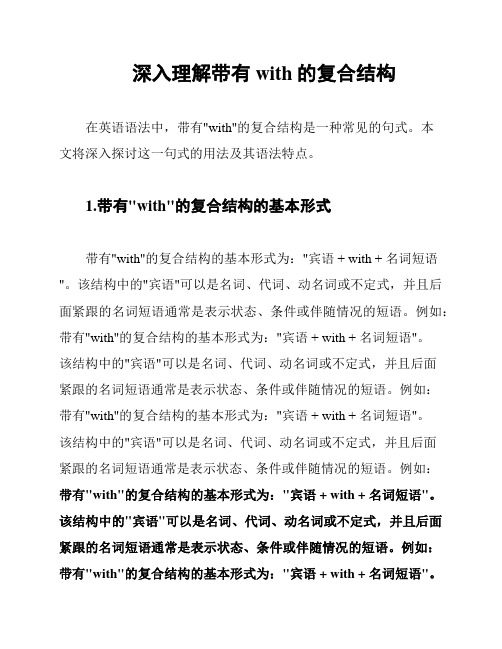
深入理解带有with的复合结构在英语语法中,带有"with"的复合结构是一种常见的句式。
本文将深入探讨这一句式的用法及其语法特点。
1.带有"with"的复合结构的基本形式带有"with"的复合结构的基本形式为:"宾语 + with + 名词短语"。
该结构中的"宾语"可以是名词、代词、动名词或不定式,并且后面紧跟的名词短语通常是表示状态、条件或伴随情况的短语。
例如:带有"with"的复合结构的基本形式为:"宾语 + with + 名词短语"。
该结构中的"宾语"可以是名词、代词、动名词或不定式,并且后面紧跟的名词短语通常是表示状态、条件或伴随情况的短语。
例如:带有"with"的复合结构的基本形式为:"宾语 + with + 名词短语"。
该结构中的"宾语"可以是名词、代词、动名词或不定式,并且后面紧跟的名词短语通常是表示状态、条件或伴随情况的短语。
例如:带有"with"的复合结构的基本形式为:"宾语 + with + 名词短语"。
该结构中的"宾语"可以是名词、代词、动名词或不定式,并且后面紧跟的名词短语通常是表示状态、条件或伴随情况的短语。
例如:带有"with"的复合结构的基本形式为:"宾语 + with + 名词短语"。
该结构中的"宾语"可以是名词、代词、动名词或不定式,并且后面紧跟的名词短语通常是表示状态、条件或伴随情况的短语。
例如:带有"with"的复合结构的基本形式为:"宾语 + with + 名词短语"。
该结构中的"宾语"可以是名词、代词、动名词或不定式,并且后面紧跟的名词短语通常是表示状态、条件或伴随情况的短语。
with复合结构用法全归纳及例句

with复合结构用法全归纳及例句一、概念复合结构“with+宾语+宾语补足语”是一个很有用的结构,它在句中主要用作状语,表示伴随、原因、时间、条件、方式等;其中的宾语补足语可以是名词、形容词、副词、现在分词、过去分词、不定式、介词短语等。
二、with复合结构句法功能1.with始结构,中表状态或说明景情况该结构常做伴随、式因、条件等状语。
例句: With machinery to do all the work, they will soon have got in the crops.于所有的工作都是由机器进行,他们将很快收完庄稼。
(原因状语)2.with复合结构可以作定语例句: Anyone with its eyes in his head can see it' s exactly like a rope.任何一个头上长着眼睛的人都能看出它完全像一条绳子。
三、用法1.表示方式、手段或工具等时(=以,用),注意不要受汉语意思的影响而用错搭配。
2.与某些抽象名词连用时,其作用相当于一个副词。
3.表示条件时,根据情况可与虚拟语气连用。
4.比较with和as:两者均可表示“随着”,但前者是介词,后接名词或代词;后者是连词,用于引导一个句子。
5.with的复合结构“with+宾语+宾语补足语”是一个很有用的结构,它在句中主要用作状语,表示伴随、原因、时间、条件、方式等;其中的宾语补足语可以是名词、形容词、副词、现在分词、过去分词、不定式、介词短语等。
如:(1)with+宾语+形容词He often sleeps with the windows open.他常开着窗睡觉。
Don’t speak with your mouth full.不要满嘴巴食物说话。
(2)with+宾语+副词He stood before his teacher with his head down.他低着头站在老师面前。
With复合结构的用法小结
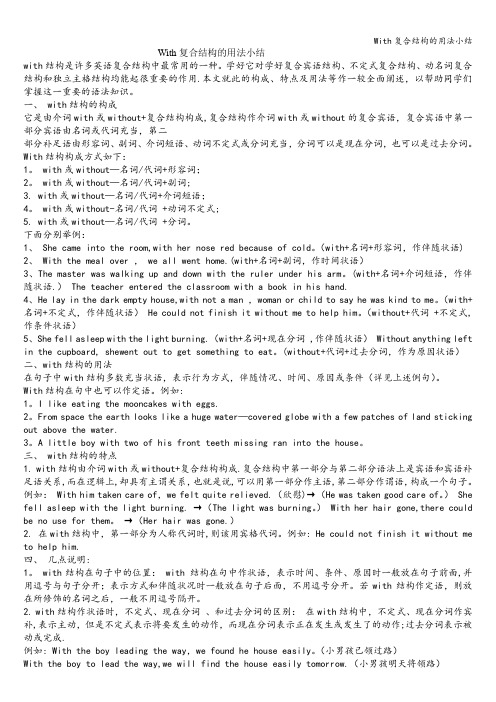
With复合结构的用法小结with结构是许多英语复合结构中最常用的一种。
学好它对学好复合宾语结构、不定式复合结构、动名词复合结构和独立主格结构均能起很重要的作用.本文就此的构成、特点及用法等作一较全面阐述,以帮助同学们掌握这一重要的语法知识。
一、 with结构的构成它是由介词with或without+复合结构构成,复合结构作介词with或without的复合宾语,复合宾语中第一部分宾语由名词或代词充当,第二部分补足语由形容词、副词、介词短语、动词不定式或分词充当,分词可以是现在分词,也可以是过去分词。
With结构构成方式如下:1。
with或without—名词/代词+形容词;2。
with或without—名词/代词+副词;3. with或without—名词/代词+介词短语;4。
with或without-名词/代词 +动词不定式;5. with或without—名词/代词 +分词。
下面分别举例:1、 She came into the room,with her nose red because of cold。
(with+名词+形容词,作伴随状语)2、 With the meal over , we all went home.(with+名词+副词,作时间状语)3、The master was walking up and down with the ruler under his arm。
(with+名词+介词短语,作伴随状语.) The teacher entered the classroom with a book in his hand.4、He lay in the dark empty house,with not a man ,woman or child to say he was kind to me。
(with+名词+不定式,作伴随状语) He could not finish it without me to help him。
with的七种复合结构用法
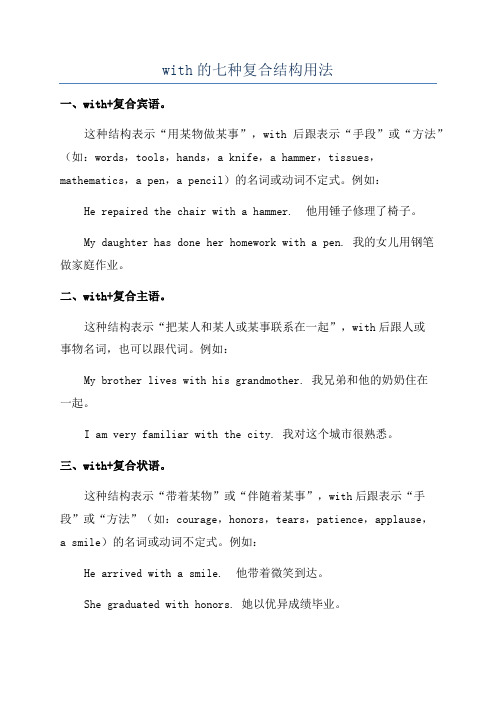
with的七种复合结构用法一、with+复合宾语。
这种结构表示“用某物做某事”,with后跟表示“手段”或“方法” (如:words,tools,hands,a knife,a hammer,tissues,mathematics,a pen,a pencil)的名词或动词不定式。
例如:He repaired the chair with a hammer. 他用锤子修理了椅子。
My daughter has done her homework with a pen. 我的女儿用钢笔做家庭作业。
二、with+复合主语。
这种结构表示“把某人和某人或某事联系在一起”,with后跟人或事物名词,也可以跟代词。
例如:My brother lives with his grandmother. 我兄弟和他的奶奶住在一起。
I am very familiar with the city. 我对这个城市很熟悉。
三、with+复合状语。
这种结构表示“带着某物”或“伴随着某事”,with后跟表示“手段”或“方法”(如:courage,honors,tears,patience,applause,a smile)的名词或动词不定式。
例如:He arrived with a smile. 他带着微笑到达。
She graduated with honors. 她以优异成绩毕业。
四、with+复合表语。
这种结构表示“和……一起”,with后跟名词、代词、形容词或动词不定式。
例如:The house is furnished with modern furniture. 这个房子里有现代家具。
The room is filled with sunshine. 这个房间里充满阳光。
五、with+复合宾语从句。
这种结构表示“做某事时考虑某事”,with后有从句,这个从句有时是否定的。
例如:He dealt with the problem with much patience. 他耐心地处理这个问题。
- 1、下载文档前请自行甄别文档内容的完整性,平台不提供额外的编辑、内容补充、找答案等附加服务。
- 2、"仅部分预览"的文档,不可在线预览部分如存在完整性等问题,可反馈申请退款(可完整预览的文档不适用该条件!)。
- 3、如文档侵犯您的权益,请联系客服反馈,我们会尽快为您处理(人工客服工作时间:9:00-18:30)。
“with+ 复合宾语”结构归纳
“with+复合宾语”是高中教学的难点,也是高考的考点,在句中可作时间状语、条件状语、方式状语、原因状语、伴随情况等。
为了帮助同学们掌握其特点,将其用法归纳如下:
1.with+名词+形容词:
如:Before he came here, my father used to sleep with his eyes open.我父亲来这儿之前,常常睁着眼睛睡觉。
(注意:with不能用while来替换。
)(表示伴随情况)
2.with+名词+副词:常用的副词是:in, on, over, out等。
如:He was standing there with nothing on.他一丝不挂地站在那里。
(表示伴随情况。
)
We went home with our work over.我们工作做完就回家了。
(表示时间。
)
3.with+名词+介词短语:
如:The teacher came into the classroom with a book in his hand.= The teacher came into the classroom, book in hand.老师手里拿着本书走进了教室。
(表示伴随情况。
)
The soldier had him stand with his back to his father.士兵让他背向着父亲站着。
(表示行为方式。
)
4.with+名词+过去分词:
如:He stood for an instant with his hand still raised.他站了一刹那,他的手仍然举着。
(raised与with的宾语hand有逻辑上的动宾关系。
)
I will have to buy a new one with my glasses broken.(broken与with 的宾语glasses有逻辑上的动宾关系。
)
5.with+名词+现在分词:
如:The English class ended with all singing an English song.英语课以全体合唱一首英语歌而结束。
(singing与with的宾语all有逻辑上的主谓关系。
)
6.with+名词+不定式:
如:With something important to talk about with you, you must stay here.由于有很重要的事情和你商量,你必须留下。
(表示原因。
)
还要特别注意的是“with+复合宾语”结构与独立主格有着密切联系,在表示条件、时间和原因时,两者可相互转换。
例如:“My wife did not go to work yesterday with my father being ill.”可转换成“My father being ill, my wife did not go to work yesterday.我的妻子昨天没去上班,因为我父亲有病了。
“She coming, please let me know.”可转换成“Please let me know with her coming.如果他来了,请通知我一声。
